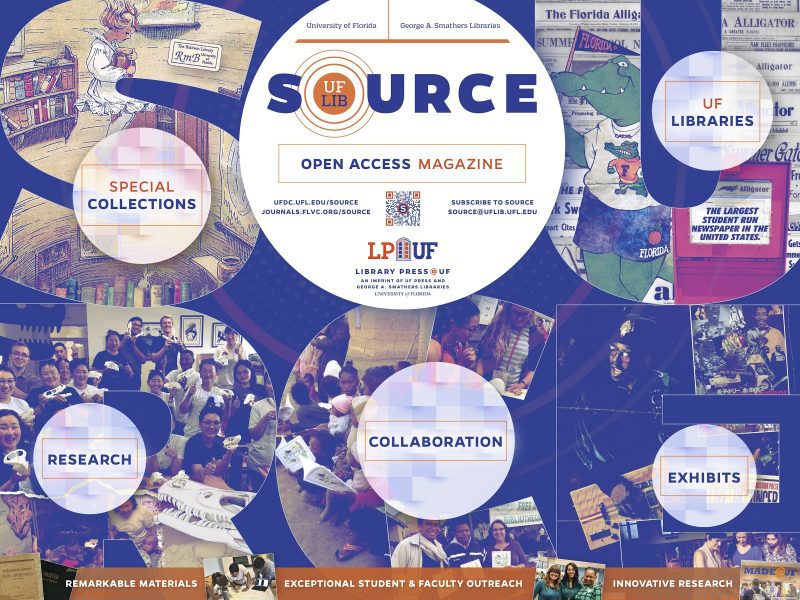Editor’s note: When we changed the 2020 Library Publishing Forum to a virtual conference format, we gave presenters the option of converting their presentations into blog posts. This is a guest post in that series.
By Tracy MacKay-Ratliff, Perry Collins, Chelsea Johnston, and Laurie Taylor

Collaboration as Foundation
Launched in 2018, SOURCE has evolved into a recurring publication and hallmark of the LibraryPress@UF (LP@UF) program. While building upon a familiar model of the in-house magazine, SOURCE increasingly serves as a platform for public scholarship that draws on contributions from the University of Florida Libraries’ employees, students, and partners. Situated within a very large academic research library with almost 300 employees and seven branches across campus, the magazine makes visible the individuals who bring projects to fruition and highlights connective threads across units and collections. SOURCE has featured 27 unique authors in its three published issues.
SOURCE relies on a collaborative editorial model, with a standing committee made up of volunteers from across the Libraries, a representative from Libraries Communications, and the four-person LP@UF team. This team—the authors of this post—act respectively as Editor-in-Chief (Laurie Taylor), Managing Editor & Designer (Tracy MacKay-Ratliff), and Associate Editors (Perry Collins and Chelsea Johnston). The committee meets on at least a quarterly basis and participates in generating and soliciting feature articles, but we have increasingly placed responsibility for final review, copyediting, and proofreading on LP@UF to avoid an onerous process of collation-by-committee.
Policies and Better Practices
We envision SOURCE as a boundary object, a common project that offers enough flexibility for different stakeholders to find and make their own meaning (Star and Griesemer, 1989). The magazine acts as a mechanism to amplify student voices and undergraduate research; to acknowledge and credit work that might otherwise be ephemeral; to forge connections across siloed parts of the Libraries; and to highlight the Libraries’ impact for our donor community.
For the LP@UF team, SOURCE offers an opportunity for us to iteratively document and improve our policies and underlying values in ways we aim to extend across our publishing program.* This initiative has informed our approach to topics such as rights retention—all authors explicitly retain copyright in their work—and reinforced our commitment to open access as a vision that should emphasize public engagement and accessibility.
Investing in Design & Materiality
The LP@UF program includes not only SOURCE but also projects ranging from collection catalogues to children’s literature to textbooks. Throughout these projects, we share an interest in leveraging form and design in ways that connect with our intended audience. This can lead to trade-offs, as an intentional commitment to boutique publications limits the number of projects we can accept in a given year. However, for all publications, we create at least one component (e.g., a book cover) that sets a publication apart. This allows us to provide graphic design support to all works, while recognizing workload limits.
For SOURCE, we produce a small print run of about 400 copies per issue, but the digital PDF also evokes the materiality of a print publication through techniques such as collage, texture, and shadow. Tracy, Managing Editor & Designer, has dedicated a significant amount of time and care in building up a foundational graphic suite—including logos, fonts, and templates—as well as unique elements that represent the tone of each feature story and aid the reader in navigating a highly visual publication.
Next Steps
For the past year, LP@UF has undertaken several projects—including a survey, a resource guide, and a dedicated graduate internship—focused on concrete ways to promote equity and justice in our work. SOURCE includes a wide variety of contributors, and the committee has a shared interest in highlighting projects that center BIPOC voices as well as other typically underrepresented communities such as non-faculty staff and students. The current rise of an antiracist movement and discussions within our own library around systemic racism have made it clear that we need to do more. Through this year, we plan to transition from implicitly shared values to better documented, formalized policies for recruiting new committee members, soliciting content and peer feedback, and prioritizing critical work and conversations. With these examples for reference and inspiration, we hope to encourage better practice among other journals partnering with LP@UF.
References
Star, Susan; Griesemer, James (1989). “Institutional Ecology, ‘Translations’ and Boundary Objects: Amateurs and Professionals in Berkeley’s Museum of Vertebrate Zoology, 1907-39”. Social Studies of Science. 19 (3): 387–420. doi:10.1177/030631289019003001
Acknowledgement
* Thanks to Dave Ghamandi for his discussion of “better practices” during the closing session of the Library Publishing Forum in 2019. A focus on iterative improvement and refinement of our practices and values is crucial to LP@UF, even as we resist the notion of a single, “best” framework.
